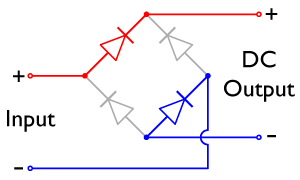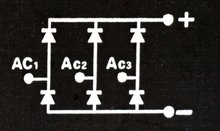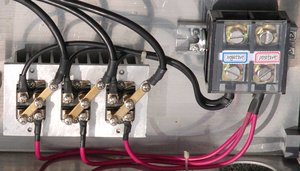Diode bridge
|
|
A diode bridge is an electronic circuit that provides the same polarity of output voltage and current for both possible polarities of input power. When used in its most common application, for conversion of alternating current (AC) input power into direct current (DC) output power, it is known as a bridge rectifier. The diagram (using a popular schematic layout with the four diodes forming the sides of a diamond) describes one diode-bridge design, the full-wave rectifier or Graetz circuit. This design is used to rectify single phase AC when no center tap is available.
Diode-photo.JPG
Missing image
Diodebridge1.png
Image:Diodebridge1.png
The essential feature of this circuit is that for both polarities of the voltage between the bridge inputs, the polarity of the outputs is the same.
For example, when the input connected at the left corner of the diamond is positive with respect to the one connected at the right, current flows to the right across the upper colored path, and overall to the left across the lower one.
When the right input is positive relative to the left, current flow is overall diagonally up to the right, and diagonally up to the left.
AC,_half-wave_and_full_wave_rectified_signals.PNG
In each of those cases, the top right output remains positive with respect to the lower right one. Since this is true whether the input is AC or DC, this circuit not only produces DC power when supplied with AC power: it also can provide what is sometimes called "polarity guard" function. That is, it permits normal functioning when batteries are installed backwards or DC input-power supply wiring "has its wires crossed" (and protects the circuitry it powers against damage that might occur without this circuit intervening).
Prior to availability of semiconductor electronics, such a bridge rectifier was always constructed from discrete components (i.e. by connecting up two wires on each of four separate diodes). In the last half of the 20th century, a single four-terminal component where the four diodes are effectively wired inside the permanently sealed device became a standard commercial component, available with various voltage and current ratings.
For many applications, especially with single phase AC where the full-wave bridge serves to convert AC current into DC current, the addition of a capacitor may be important because the bridge alone supplies voltage and current of fixed polarity but varying magnitude.
Missing image
Diodebridge4.png
Image:Diodebridge4.png
The function of this capacitor is to lessen the variation (generally over periods of tens of milliseconds or shorter) in the output. (The standard electronics shorthand for this effect is that the capacitor provides a low impedance path to the AC component of the output, attenuating the AC voltage across, and AC current through, the resistive load.) In a less technical terms, because the charge stored in the capacitor and the voltage between its terminals have a fixed ratio, any drop in the output voltage and current of the bridge tends to be cancelled by loss of charge by the capacitor, this charge flowing out as additional current through the load. Thus the change of total current and voltage is reduced relative to what would occur without the capacitor; increases of voltage correspondingly produce current into the capacitor, similarly moderating the change in net output.
For three phase AC, a full wave bridge rectifier consists of six diodes.
da:Diodebrokoblingde:Gleichrichterbrücke fr:Pont de diodes nl:Bruggelijkrichter pl:Mostek Graetza




